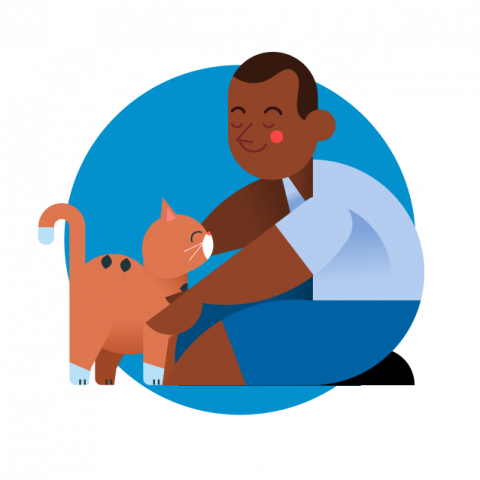What is our goal?
To make certain the medical and behavioural needs of our animals are correctly assessed and effectively addressed.
Where are we now?
We are achieving this for dogs — but want to further improve how quickly problems are identified.
We are not achieving this for cats.
Perfomance highlight 2022/2023
Recent updates
Our Extra TLC for Pets, enrichment program was launched in the media. The program has a dedicated team of 25 volunteers who regularly do the rounds of our North Melbourne shelter to read books to our dogs, blow bubbles with our cats and take part in cuddle time inside animals' pens that are a little bit more worried about the shelter environment. The program provides additional enrichment for the animals in our care, beyond walks, toys, Kongs, pats and the general love and attention our staff can give to them. The purpose is to reduce stress levels for our animals and contribute to the overall wellbeing during their time with us until we can find their forever homes.
Our team of veterinary professionals are highly qualified and experienced. No animal is ever knowingly left to suffer.
We are confident in our behaviour assessments for dogs but there is always room for further improvements. We have introduced a better planned in-kennel enrichment program, incorporating diverse experiences for our dogs: audio, scent, visuals, and food — on a daily basis. We would also like to implement dog playgroups, assessing dog friendly dogs, and carefully introducing them to each other for playtime.
There is more we can do to meet the enrichment needs of both cats and dogs. We want to be more proactive in recognising signs of stress and anxiety earlier than we presently do. The quicker we can react to and address behavioural issues, the faster we can move animals either into foster care or adoption. We also want to achieve better consistency in how we treat assessments and enrichment for cats.
The problem of the sheer numbers of unsocialised semi-wild and wild cats we receive into the shelter during kitten season is a serious challenge for us. We do not have the resources for prolonged and extensive behaviour management for the hundreds of cats and kittens we receive into our care during this period.

Where do we need to be?
Recognising signs of distress immediately with the ability to act upon it.
Significantly reducing the length of stay for cats and dogs to reduce the risk of behaviours developing.

How will we advance?
- More staff trained to recognise animal body language and behaviour to a level they can identify stress and anxiety quickly and flag it for remedial action.
- Introduce a procedure for trained role-models and mentors to buddy with new front-line staff.
- Provide similar training for our foster-carers to catch issues quickly and avoid escalation.
- Introduce similar process of behaviour assessments on arrival into the shelter for cats, as we already do for dogs.
- Implement detailed behaviour plans for cats, to carry through into foster and/or adoption.
- Modify our cat condos to remove the back window (condos have windows at both the front and back). This will reduce exposure and give our more scared cats greater privacy and sense of security.
- Provide housing for all cats categorised as ‘unsocial’ (may be feral) on arrival to allow them at least 72 hours to decompress prior to assessment if suitable for adoption.




